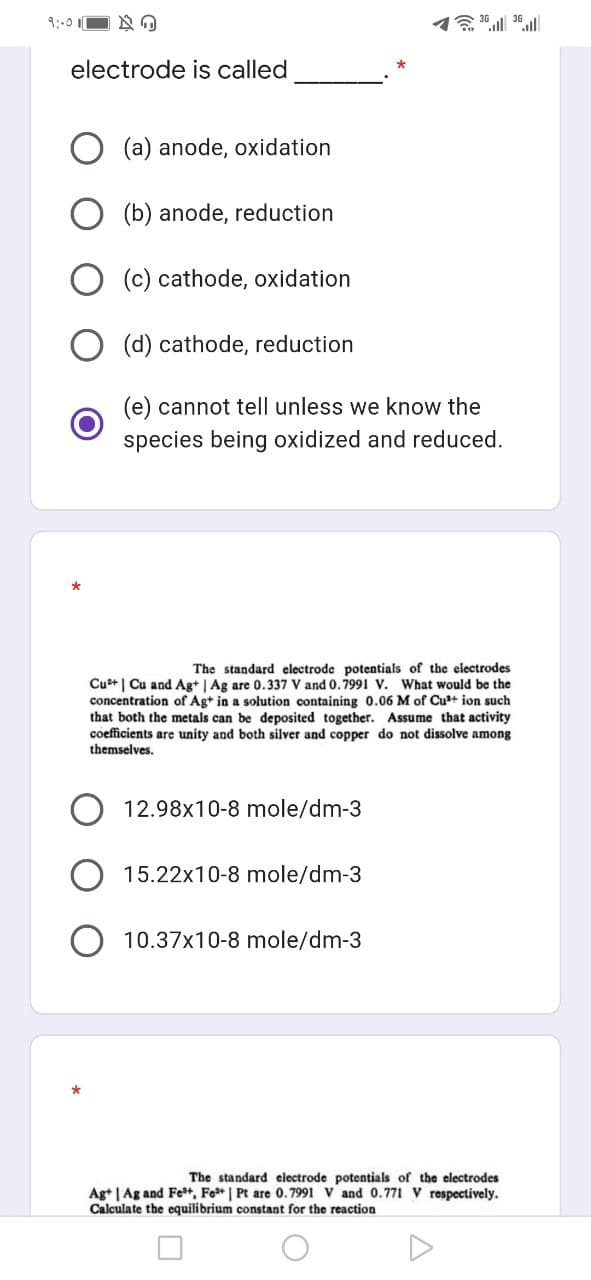Chemistry: Principles and Practice
3rd Edition
ISBN:9780534420123
Author:Daniel L. Reger, Scott R. Goode, David W. Ball, Edward Mercer
Publisher:Daniel L. Reger, Scott R. Goode, David W. Ball, Edward Mercer
Chapter18: Electrochemistry
Section: Chapter Questions
Problem 18.101QE: At 298 K, the solubility product constant for PbC2O4 is 8.5 1010, and the standard reduction...
Related questions
Question

Transcribed Image Text:9:-0
electrode is called
(a) anode, oxidation
(b) anode, reduction
O (c) cathode, oxidation
(d) cathode, reduction
(e) cannot tell unless we know the
species being oxidized and reduced.
The standard electrode potentials of the electrodes
Cu+ | Cu and Ag+ | Ag are 0.337 V and 0.7991 V. What would be the
concentration of Ag+ in a solution containing 0.06 M of Cu*+ ion such
that both the metals can be deposited together. Assume that activity
coefficients are unity and both silver and copper do not dissolve among
themselves.
12.98x10-8 mole/dm-3
15.22x10-8 mole/dm-3
10.37x10-8 mole/dm-3
The standard electrode potentials of the electrodes
Ag+ | Ag and Fe+, Fe* | Pt are 0.7991 V and 0.771 V respectively.
Calculate the equilibrium constant for the reaction
Expert Solution
This question has been solved!
Explore an expertly crafted, step-by-step solution for a thorough understanding of key concepts.
Step by step
Solved in 2 steps

Knowledge Booster
Learn more about
Need a deep-dive on the concept behind this application? Look no further. Learn more about this topic, chemistry and related others by exploring similar questions and additional content below.Recommended textbooks for you

Chemistry: Principles and Practice
Chemistry
ISBN:
9780534420123
Author:
Daniel L. Reger, Scott R. Goode, David W. Ball, Edward Mercer
Publisher:
Cengage Learning

Chemical Principles in the Laboratory
Chemistry
ISBN:
9781305264434
Author:
Emil Slowinski, Wayne C. Wolsey, Robert Rossi
Publisher:
Brooks Cole

Chemistry: An Atoms First Approach
Chemistry
ISBN:
9781305079243
Author:
Steven S. Zumdahl, Susan A. Zumdahl
Publisher:
Cengage Learning

Chemistry: Principles and Practice
Chemistry
ISBN:
9780534420123
Author:
Daniel L. Reger, Scott R. Goode, David W. Ball, Edward Mercer
Publisher:
Cengage Learning

Chemical Principles in the Laboratory
Chemistry
ISBN:
9781305264434
Author:
Emil Slowinski, Wayne C. Wolsey, Robert Rossi
Publisher:
Brooks Cole

Chemistry: An Atoms First Approach
Chemistry
ISBN:
9781305079243
Author:
Steven S. Zumdahl, Susan A. Zumdahl
Publisher:
Cengage Learning

Chemistry
Chemistry
ISBN:
9781305957404
Author:
Steven S. Zumdahl, Susan A. Zumdahl, Donald J. DeCoste
Publisher:
Cengage Learning


Principles of Modern Chemistry
Chemistry
ISBN:
9781305079113
Author:
David W. Oxtoby, H. Pat Gillis, Laurie J. Butler
Publisher:
Cengage Learning